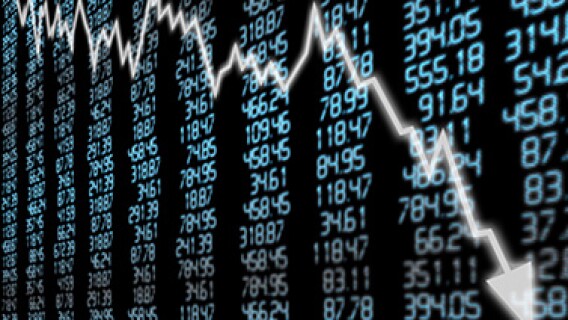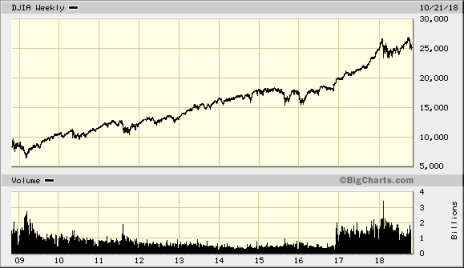It’s been a fantastic ride for the markets since the 2009 low of 6,443.27. The Dow Jones Industrial Average has gained more than 251%—some 18,000 points since then. And as you can see from the following chart, the ride has not been without periods of volatility.
After the initial rebound following the recession, the market nosed down in the last half of 2011, and again in 2015 and 2016, leaving investors wondering if the bull market was coming to an end. Of course, it wasn’t, and the markets have continued to set new highs since.
But since the beginning of October, we’ve seen a demonstration of the October effect—a theory that stocks tend to decline during the month of October. There have been lots of examples of that theory becoming reality, including the Panic of 1907, Black Tuesday (1929), Black Thursday (1929) Black Monday (1929) and Black Monday (1987).
And since the markets have risen so much so quickly, multi-hundred-point moves in either direction have become more frequent.
I’m no soothsayer, but here at Cabot, we always pay attention to the markets. We can’t predict tomorrow, but Mike Cintolo and Tim Lutts are really good at interpreting market signals, and they see this current environment as a time to remain defensive in your portfolios.
As well, my expert contributors to my newsletters, Wall Street’s Best Investments and Wall Street’s Best Dividend Stocks, are investment pros with decades of profiting during wild market swings, and in every issue, I also include a sampling of their market views, including this one from Jon Markman, editor of Tactical Options, from my most recent issue of Wall Street’s Best Investments:
“Time to Trim Riskier Options. A combination of fast-rising bond yields and continuing trade fears has stirred investors to cut riskier stocks from their portfolios, who are worrying that the huge profit margins among many of these companies will fall.”
Jon was talking about rebalancing portfolios, a very important strategy to combat a volatile market.
We all love it when the markets go up, up, up, but inevitably, they also go down. And when that happens, many investors gather at one of two extremes: 1) Cash in everything; or 2) Do nothing. And both of those are usually the exact wrong moves during downturns.
Most investors who sell out their portfolio will miss out on the up days, and will get back in way too late to take maximum advantage of the market turn (which always comes!). And those who “stay the course” during the down days will needlessly suffer the emotional stress of what can be a very wild ride.
After my years in the investing world, I’ve decided that it’s just human nature—we hate to plan. And that avoidance makes us love to buy stocks and hate to sell them. When the market is in an upward trend, we often become so excited that we begin to buy stocks, willy-nilly, with no thought to a balanced portfolio. And when the market drops, we become frozen, not knowing whether we should continue to buy more, to take advantage of the lower prices or just bail out and sell everything.
The result is usually this: When under pressure, investors will generally make exactly the wrong decision!
So, it just makes sense to realize that what goes up must come down, and while my advisories, Wall Street’s Best Investments and Wall Street’s Best Dividend Stocks, are all about finding fabulous—and profitable—recommendations for our readers, we would be remiss if we didn’t also offer ideas to protect your portfolios, in times of pullbacks or excessive volatility.
Bottom line: You don’t have to make the same mistakes. Instead, with a little thought and planning, you can create an all-weather portfolio.
In 2018, investors have seen some huge market swings. And in such a volatile market, it’s more important than ever that investors not only consider investing for gains, but also invest in protecting their existing portfolios.
Planning is no guarantee that you won’t ever lose money, because there are no guarantees in the stock market. But there are steps you can take to minimize your losses and also maximize your profits.
5 Steps for Profiting in a Volatile Market
1. Set a price target the day you purchase your stocks. Your target should be based on the P/E of your stock, multiplied out by expected future earnings. I recommend that you at least think about what price your stock can achieve within 18-24 months. And that should at least be a 30%-50% gain. If it doesn’t have that potential, keep looking.
Going forward, when the stock hits your target, reevaluate it and determine if it has the ability to continue double-digit price gains or if you would gain more by cashing in now and using those funds to purchase a different stock with more potential.
Many of the contributors to my newsletters make this decision easy for you, by providing targets for their recommendations, and often cash in just a portion of the holding to take some profits and let the remaining half ride toward a new target.
2. Set a stop-loss limit the day you purchase your stocks. For aggressive investors, the stop-loss could be 30% or more. For more conservative investors, you might be happier with a stop-loss of 10%.
The actual percentage is not as important as being disciplined in exercising the stop losses. Sure, no one likes to lose money, but a stock riding momentum down can clean you out in no time, so it’s best to take your losses. If the stock bounces back, you can always buy back into it. Many of our advisors provide stop losses for you, but it’s always a good idea to consider your own investing strategies when setting your stop losses.
With technology and biotech stocks—which tend to be more volatile than more conservative companies—it’s a good idea to set your stop losses a little wider.
For example, with Ionis Pharmaceuticals (IONS), I would suggest a 30% trailing stop. That way, if the market just causes the shares to slip a bit one day, it allows you to ride out a temporary drop, without inadvertently cashing out of a company with excellent long-term potential.
3. Diversify your portfolio to reduce your overall portfolio risk, as well as volatility. That means creating a portfolio with non-correlating assets, which, theoretically, results in assets that react differently to market catalysts. When market action causes some of your assets to decline in value, others should rise, effectively providing protection against your entire portfolio declining at the same time.
Consequently, you should own small-, mid- and large-cap stocks; companies in different sectors; and value and growth stocks.
And while you may think you are properly diversified because you may have 10 different technology stocks that operate in totally different segments, remember that they are all still technology stocks—companies that tend to do very well when the economy is steaming ahead, and folks have plenty of money to upgrade.
You should also have exposure to international stocks, either through owning multinational companies or via exchange-traded funds (ETFs).
And don’t forget about fixed income investments. In rising rate cycles (like the one we are now in), bonds can be attractive. As well, some investors may want to add currencies, commodities and real estate to their portfolios, as hedges against stock market volatility.
With 40 or more recommendations coming your way each month in Wall Street’s Best Investments, you won’t have any problem choosing stocks from almost every industry to help you diversify your holdings.
Of course, the actual composition of your portfolio will depend on your personal investment goals, your age, and your risk profile, so make sure you know the kind of investor you are so that your portfolio will match up to your goals.
4. Put some dividend-paying stocks in your portfolio. They are a great hedge against inflation and provide terrific portfolio gains in down market cycles.
Years ago, during the tech boom, I began adding dividend stocks, such as regional banks and Real Estate Investment Trusts (REITs) to my portfolio. The payoff was great! When the tech stocks hit the dust and the market took a downturn, I was still earning some great returns on my dividend stocks. Many investors neglect these companies as they think they are too boring. But, what’s boring about making money?
And the pages of Wall Street’s Best Dividend Stocks also include a nice array of companies that pay dividends.
For example, in my October issue, my contributors—with an eye to portfolio protection, while also taking advantage of market growth spurts—recommended 10 higher-yielding stocks, providing some great cash flow during market ups and downs. These included companies in the gaming, energy, financial, real estate, retail, and consumer products industries.
With so much cash available to companies over the past few years, stocks from every genre—including technology and emerging markets—will often pay a dividend. And that just adds to your profits.
5. Rebalance and reposition your portfolio. This is a step that so many investors ignore—to their peril. During the tech boom of the early 2000s, technology companies were chased to the stratosphere by investors who had no idea what they were buying; they just saw triple-digit overnight gains, and jumped right in. But the signs of the bust were everywhere.
I saw price-equity ratios as high as 1,500. Warren Buffett stayed out of the fray, cautioning investors not to buy “what they couldn’t explain to their grandmothers”.
I interviewed a founder of the Real Estate Investment Trust industry during those heady days and asked him if he was buying any properties in the Silicon Valley area. He laughed, and said, “No, I wouldn’t touch them with a 10-foot pole; companies in the high-tech corridor have no cash; they want to pay rent with their stock options!”
So, pay attention to the sectors in your portfolio, too, and load up on steadier stocks in more mundane industries during periods of volatility, while trimming your positions in riskier assets. Taking a flyer on speculative stocks is often a lot of fun, but it’s best to keep those to a small portion of your holdings—especially during erratic markets.
Bottom Line
For most investors, following the above five steps will help you create a portfolio that will thrive through normal up and down market cycles. While an undiversified portfolio can give you tremendous gains—if you are lucky enough to choose only “home-run” stocks—the plain truth is that most investors (individual or professional) don’t have a crystal ball. And stocking your portfolio with just one type of company or sector—no matter how promising—is a recipe for failure, long-term.
So, do yourself a favor, and take advantage of the tools that are available. And with technology today, it’s never been easier to take command of your investments.
And if you need a little extra help navigating the current volatile market, click here.

Learn More

Learn More

Learn More

Learn More


